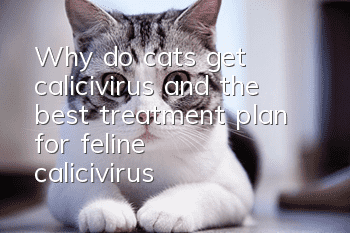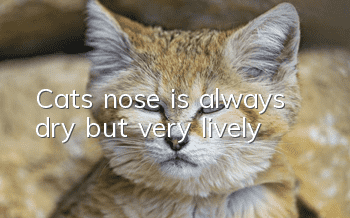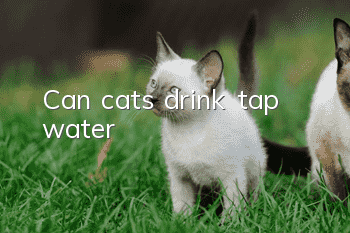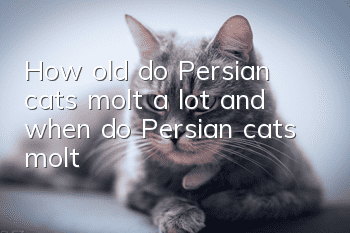Why do cats get calicivirus and the best treatment plan for feline calicivirus!

Why do cats get calicivirus? Feline calicivirus is a multiple respiratory infectious disease with a high incidence rate, but fortunately, the mortality rate of this disease is not high. The disease mainly manifests as upper respiratory tract symptoms, namely depression, serous and mucoid rhinorrhea, conjunctivitis, stomatitis, tracheitis, bronchitis, accompanied by biphasic fever.
Under natural conditions, only felines are susceptible, and it often occurs in cats aged 6-84 days. The main sources of infection of this disease are sick cats and virus-carrying cats. The former can discharge a large amount of virus with secretions and excretions in the acute phase, contaminating utensils, floors and objects, and can also be directly transmitted to cats. The latter is generally transformed from acute-stage cases. Although the clinical symptoms disappear, it can detoxify for a long time and is the most important and dangerous source of infection.
The best treatment plan for feline calicivirus:
· Recover dehydration through infusion
· Electrolyte supply
· Nutritional support
· NSAID analgesia (nonsteroidal anti-inflammatory drugs)
·Remove secretions
· Mucolytic agents if purulent secretions are present
· Interferon
· If you have pneumonia, get oxygen
Cats infected with calicivirus are susceptible to sniffing due to loss of appetite caused by fever, mouth sores, and nasal congestion. If you don't eat for more than 3 days, you may need to force-feed using a tube. In the case of severe stomatitis, broad-spectrum antibiotics, glucocorticoids, immunosuppressants, etc. can be used to prevent secondary infections.
Preventing Feline Calicivirus Infection
Because it is a non-enveloped virus, it is resistant to disinfection and continues to survive in the environment for a long time. Thorough disinfection is necessary, especially in multi-breeding environments, and inactivation of viruses.
Vaccination
Vaccines against feline calicivirus are listed as "core vaccines" for vaccination, regardless of the growing environment. Vaccines work to reduce symptoms when infected with a virus, never to prevent the infection itself or to control viral shedding after infection.
Vaccination schedule
The transferred immunity to calicivirus received from the mother cat when the kittens are born is halved by approximately 15 days after birth. Although individual differences vary widely, antibody titers are estimated to be highest after birthIt lasts from 10 to 14 weeks, so it is necessary to vaccinate at a time when immunity is declining and acquired immunity is forming in the body. A common vaccination schedule is the first dose at 6 to 8 weeks of age, the second dose at 3 to 4 weeks apart, and the third dose at 16 to 20 weeks of age when transitional antibodies are sufficiently weakened. Get vaccinated after one year.
Virus disinfection
Although feline calicivirus does not survive a day in a dry environment at 37°C, it has been shown to maintain infection for 21 to 28 days in a dry environment at room temperature, or for 60 days or more in a dry environment at 4°C. That's why it can cause viral respiratory infections as well as herpes type I during cold winter months. Because the virus can be transmitted from cat to cat through contact with the culture medium to which the virus is attached, in a polytopic environment the virus must be firmly inactivated.
Small items that can be boiled and sterilized
To inactivate feline calicivirus with hot water, boil and sterilize at 70°C for 5 minutes and 100°C for 1 minute. Cats may put things in their mouths, such as cat dishes and toys, and when sterilizing small items that can be put in the pot, it's best to use hot water instead of medication.
Chemical disinfection of facilities
When using drugs to disinfect feline calicivirus, active ingredients must be used. The concentration should be well maintained to completely inactivate the virus.
Disinfection of clothing and textile products
Bleach containing bleach activators has been reported to have strong virucidal activity. In particular, those containing sodium oxybenzene sulfonate (OBS) and hydroxybenzoic acid (OBC) are considered effective. Clothing that has the virus on it should be washed with a bleach-based detergent containing the above ingredients, rather than just water.
Hand disinfection
If you try to stroke other cats with the virus attached to your fingers, the humans will become infected and spread the infection, so you must disinfect them thoroughly. It is reported that calicivirus can be washed with running water for 15 seconds, reducing the amount of virus to about 1/100 (0.64%). In addition, when a hand soap containing a surfactant component is used, the removal amount increases, and when a hand soap containing an iodine compound (povidone-iodine) is used, deactivation is promoted.
It is said that repeated washing will further reduce the number of viruses, so using medicated soap containing iodine compounds and washing hands repeatedly with water can prevent infection.
Feeding pressure
Cats infected with calicivirus often recover spontaneously and subsequently become carriers of the virus.carriers without symptoms. The virus is thought to lie dormant in the tonsils, but it cannot be ruled out that it may be hidden in other tissues. It must be noted that the virus recurs due to stress, diseases causing immunodeficiency, use of immunosuppressants, aging, malnutrition, etc., and that it is excreted in eye and nasal secretions and transferred to other cats. This is a point sometimes. First, let’s go over complete indoor husbandry. It's also important to improve the indoor environment and help your cat's stress-free life. Once infected with the virus, cats can become carriers of the virus even if their symptoms disappear. As stress can lead to diseases leading to immune deficiency, administration of immunosuppressants, aging and nutritional deficiencies, the virus may be rejected and shed again in the environment.
- What kind of cat is an orange cat? How much does one cost?
- How should I educate my cat when he poops on the bed?
- What is the personality of the Chinese civet cat?
- What does the Cheshire Cat's smile mean?
- Pregnancy care tips for British longhair cats
- What does it mean when a cat lies belly up?
- Does a Ragdoll cat's personality change when it's in heat?
- Why do cats keep purring?
- How to train a cat not to scratch or bite
- The pathogenesis and symptoms of feline chlamydia pneumonia, cat health!



